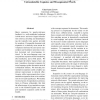142 search results - page 20 / 29 » Disambiguating Highly Ambiguous Words |
ACL
2006
13 years 9 months ago
2006
In this paper we present word sense disambiguation (WSD) experiments on ten highly polysemous verbs in Chinese, where significant performance improvements are achieved using rich ...
COLING
2008
13 years 9 months ago
2008
Supervised approaches to Word Sense Disambiguation (WSD) have been shown to outperform other approaches but are hampered by reliance on labeled training examples (the data acquisi...
KES
2010
Springer
13 years 6 months ago
2010
Springer
Document clustering is a powerful technique that has been widely used for organizing data into smaller and manageable information kernels. Several approaches have been proposed...
IRAL
2003
ACM
14 years 23 days ago
2003
ACM
Query expansion by pseudo-relevance feedback is a well-established technique in both mono- and cross- lingual information retrieval, enriching and disambiguating the typically ter...
COLING
2002
13 years 7 months ago
2002
There is no blank to mark word boundaries in Chinese text. As a result, identifying words is difficult, because of segmentation ambiguities and occurrences of unknown words. Conve...

